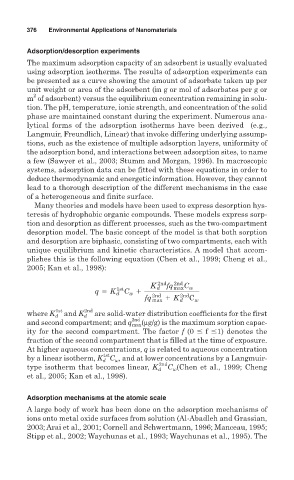Page 393 - Environmental Nanotechnology Applications and Impacts of Nanomaterials
P. 393
376 Environmental Applications of Nanomaterials
Adsorption/desorption experiments
The maximum adsorption capacity of an adsorbent is usually evaluated
using adsorption isotherms. The results of adsorption experiments can
be presented as a curve showing the amount of adsorbate taken up per
unit weight or area of the adsorbent (in g or mol of adsorbates per g or
2
m of adsorbent) versus the equilibrium concentration remaining in solu-
tion. The pH, temperature, ionic strength, and concentration of the solid
phase are maintained constant during the experiment. Numerous ana-
lytical forms of the adsorption isotherms have been derived (e.g.,
Langmuir, Freundlich, Linear) that invoke differing underlying assump-
tions, such as the existence of multiple adsorption layers, uniformity of
the adsorption bond, and interactions between adsorption sites, to name
a few (Sawyer et al., 2003; Stumm and Morgan, 1996). In macroscopic
systems, adsorption data can be fitted with these equations in order to
deduce thermodynamic and energetic information. However, they cannot
lead to a thorough description of the different mechanisms in the case
of a heterogeneous and finite surface.
Many theories and models have been used to express desorption hys-
teresis of hydrophobic organic compounds. These models express sorp-
tion and desorption as different processes, such as the two-compartment
desorption model. The basic concept of the model is that both sorption
and desorption are biphasic, consisting of two compartments, each with
unique equilibrium and kinetic characteristics. A model that accom-
plishes this is the following equation (Chen et al., 1999; Cheng et al.,
2005; Kan et al., 1998):
2nd
2nd
K d fq max C w
1st
q 5 K d C 1
w
2nd
2nd
fq max 1 K d C w
1st
where K d and K d 2nd are solid-water distribution coefficients for the first
2nd
and second compartment; and q max (µg/g) is the maximum sorption capac-
ity for the second compartment. The factor f (0 f 1) denotes the
fraction of the second compartment that is filled at the time of exposure.
At higher aqueous concentrations, q is related to aqueous concentration
1st
by a linear isotherm, K d C w , and at lower concentrations by a Langmuir-
2nd
type isotherm that becomes linear, K d C w (Chen et al., 1999; Cheng
et al., 2005; Kan et al., 1998).
Adsorption mechanisms at the atomic scale
A large body of work has been done on the adsorption mechanisms of
ions onto metal oxide surfaces from solution (Al-Abadleh and Grassian,
2003; Arai et al., 2001; Cornell and Schwertmann, 1996; Manceau, 1995;
Stipp et al., 2002; Waychunas et al., 1993; Waychunas et al., 1995). The

